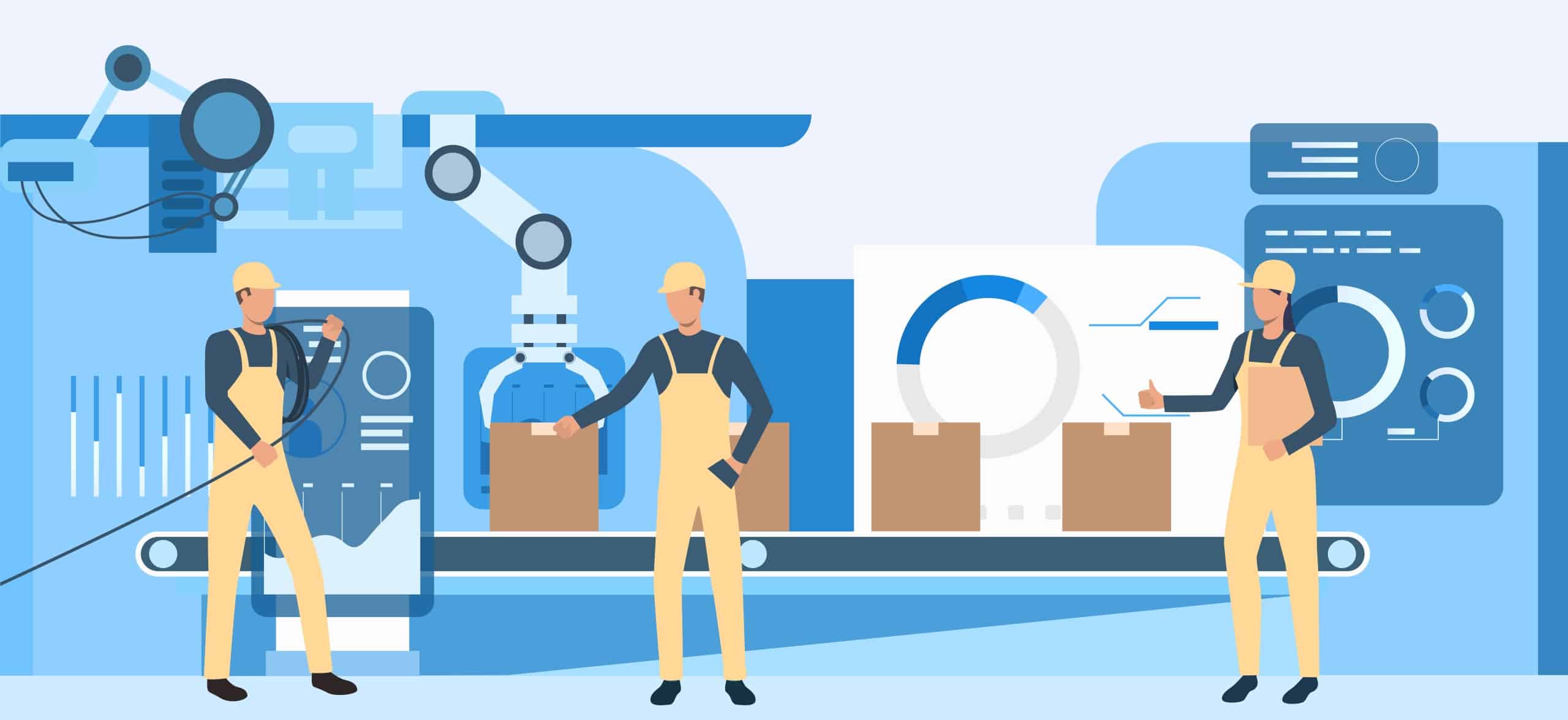1. The Power of Data Analytics
The importance of data analytics in today’s fast-paced, data-driven environment cannot be overstated. Data analytics has become an essential tool in transforming unprocessed data into valuable insights, as companies across all industries strive to gain a competitive edge. This shift has been particularly significant in the manufacturing industry, where traditional, intuition-based decision-making has given way to a more precise and informed approach.
Data analytics enables businesses to mine large databases for meaningful information that can reveal patterns, trends, and correlations that would otherwise go unnoticed. This results in a production process that is more efficient and optimized in the industrial setting. By analyzing data at every step of the process, from supply chain management to manufacturing and quality control, wet wipes manufacturers can make data-driven decisions that improve operational efficiency and support overall company performance.
Real-time monitoring is a unique feature of data analytics that is particularly valuable in the industrial sector. Real-time data analysis provides a dynamic and responsive environment that is ideal for monitoring wet wipes machine’s performance, keeping an eye on production lines, and ensuring quality control. Wet wipes manufacturers can identify bottlenecks, quickly resolve issues, and optimize workflows in real-time to increase efficiency.
Data analytics is also useful in predictive maintenance. By using machine learning algorithms and historical data, wet wipes manufacturers can plan maintenance and forecast when equipment is likely to fail. This reduces downtime, increases equipment longevity, lowers costs, and boosts overall operational effectiveness.
Quality assurance is a high priority in manufacturing, and data analytics is essential to maintaining consistency. By analyzing manufacturing data, wet wipes manufacturers can identify trends related to product quality. This level of understanding enables them to take prompt remedial action, preventing errors and deviations from reaching the final output. As a result, production matches or exceeds customer expectations and is more reliable and consistent.
Data analytics is also present in the area of supply chain optimization. By analyzing historical data, market trends, and demand patterns, wet wipes manufacturers can optimize inventory levels, improve logistics, and make informed decisions about sourcing and distribution. This increases cost-effectiveness while guaranteeing a more flexible supply chain that can adapt to changing market conditions.
In summary, data analytics is a game-changer in the industrial sector, offering unprecedented levels of accuracy, productivity, and flexibility. The success of businesses in embracing digital transformation will largely depend on their ability to use and leverage data. In addition to being better positioned to compete, wet wipes manufacturers with strong data analytics capabilities can also innovate, adapt, and thrive in the fast-paced world of modern industry.
2. Real-time Monitoring for Precision
Real-time monitoring is transforming the industrial sector by providing unprecedented levels of accuracy and responsiveness. In the context of production processes, real-time monitoring involves the continuous gathering and examination of data as it occurs, providing immediate insights into various aspects of manufacturing. This ability has proven to be especially important in industries where accuracy and productivity are critical, such as automated wet wipe manufacturing.
Real-time monitoring relies on strategically positioned sensors and advanced monitoring systems that collect data on critical factors such as temperature, pressure, speed, and quality indicators. This allows wet wipes manufacturers to observe and evaluate production line and equipment performance in real-time, making it possible to take prompt action.
One of the main benefits of real-time monitoring is that it contributes to operational efficiency. By continually analyzing data from the production floor, wet wipes manufacturers can quickly detect any bottlenecks, inefficiencies, or other issues that might affect the entire process. This enables preemptive decision-making, reducing interruptions and improving procedures. For instance, if a wet wipes machine shows signs of deviating from ideal performance, immediate adjustments can be made to ensure it operates within predetermined limits.
Real-time monitoring not only enhances efficiency but also improves the overall quality control process. Every product can be evaluated and tracked in real time as it moves through the wet wipes manufacturing process. Any deviations from quality standards result in instant notifications that facilitate immediate remedial action. This reduces the likelihood of defects reaching the end customer and ensures that every product meets strict quality standards.
Besides, real-time monitoring provides accuracy that extends beyond the confines of the industrial setting. It enables wet wipes manufacturers to gain a comprehensive understanding of the entire wet wipes manufacturing process, empowering them to make strategic decisions using real-time data. This real-time data supports flexible and adaptable wet wipes manufacturing methods, maximizing resource allocation and coordinating output with market needs.
Moreover, real-time monitoring is a key component of Industry 4.0, the fourth industrial revolution defined by the incorporation of digital technology into wet wipes manufacturing. As automated systems and Internet of Things (IoT) devices become increasingly prevalent, immediate data analysis and decision-making become more important. Real-time monitoring is the keystone that binds these technologies together, creating a dynamic and interdependent manufacturing environment.
Ultimately, real-time monitoring is the foundation of accuracy in automated wet wipe production and modern manufacturing in general. Real-time data collection, analysis, and action optimization enhance quality control and operational efficiency while enabling producers to quickly adapt to changing market conditions. Real-time monitoring is a critical tool for those who want to stay ahead in a fast-paced, fiercely competitive business environment as the industrial landscape continues to evolve.
3. Predictive Maintenance
Predictive maintenance has transformed the manufacturing industry by changing the way companies maintain and operate their equipment. Unlike traditional reactive or preventive maintenance approaches, predictive maintenance uses data analytics and machine learning algorithms to anticipate when equipment is likely to break down, enabling prompt and proactive intervention. This approach significantly impacts businesses that depend on their equipment to maintain productivity and product quality, such as the automated wet wipes manufacturing process.
The key to predictive maintenance is continuous monitoring and analysis of equipment performance data. Sensors and monitoring devices integrated into equipment gather numerous pieces of data, including temperature, vibration, pressure, and other pertinent variables. Advanced analytics technologies are then used to examine this real-time data to find trends and anomalies. This allows potential problems to be predicted before they become serious failures.
Wet wipes manufacturers can minimize downtime and production interruptions by scheduling maintenance operations at opportune periods based on predictive maintenance failure dates. This proactive approach not only lessens the impact on operating efficiency but also increases the lifetime of machines by resolving problems before they cause permanent harm. Predictive maintenance offers considerable cost savings for wet wipes manufacturers, as unexpected downtime and emergency repairs can be very expensive.
Predictive maintenance is especially critical for the equipment responsible for the complex procedures in the automated wet wipes manufacturing process, such as the liquid dispensing systems, packing apparatus, and cutting and folding processes. Anticipating and fixing such issues beforehand guarantees consistent product quality and reduces the possibility that the final user will discover flaws.
Furthermore, predictive maintenance aligns with the objectives of Industry 4.0—the fourth industrial revolution defined by the integration of smart technologies and data-driven decision-making. The predictive powers made possible by data analytics play a part in the development of “smart factories,” where equipment interacts with central systems and one another to maximize production efficiency and maintenance schedules.
In conclusion, predictive maintenance is a proactive and strategic strategy that revolutionizes how wet wipes manufacturers maintain their equipment, particularly in sectors like automated wet wipes manufacturing. By using the insights gained from data analytics, businesses can transition from reactive firefighting to a predictive and preventive maintenance model. This will increase productivity, save costs, and guarantee the dependability and durability of their equipment. Predictive maintenance is a critical enabler for companies looking to remain resilient and competitive in the face of shifting operational problems as the industrial market continues to change.
4. Quality Assurance through Data Insights
Modern wet wipes manufacturing processes heavily rely on quality assurance through data insights to ensure that wet wipes meet or exceed strict quality requirements. The use of data analytics is revolutionary in the automated wet wipes manufacturing scenario, where accuracy and consistency are crucial. By analyzing data from several stages of the wet wipes manufacturing process, producers can find patterns, trends, and deviations that affect the quality of the final product.
Wet wipes undergo several processes from raw materials to the packaged product, and each stage is subject to changes that may impact quality. Data insights provide wet wipes manufacturers with a comprehensive understanding of the wet wipes manufacturing process, enabling them to monitor critical quality indicators in real-time. Every element, such as the wet wipe material composition, the accuracy of the liquid dispensing, or the packaging’s integrity, is scrutinized to ensure predetermined quality standards are followed, thanks to data analytics.
Wet wipes manufacturers can set quality standards by analyzing historical data to determine the typical range of deviations in the manufacturing process. Data insights trigger instant warnings when deviations occur, allowing for prompt remedial action. Besides reducing the number of bad batches produced, this real-time responsiveness feeds into a cycle of continuous improvement that gradually enhances procedures.
Data insights are also crucial for root cause investigation. Wet wipes manufacturers can analyze the data to pinpoint the specific step or part that caused the quality variation. This level of detail allows for more focused responses, ensuring that the underlying reasons for quality deviations are thoroughly addressed and preventing recurrence.
Data insights not only help to identify and fix faults but also aid in predictive quality management that uses data trends and patterns to anticipate potential quality problems before they occur. Wet wipes manufacturers can improve overall quality and reduce faults by proactively adjusting processes based on the early detection of anomalies.
In addition to traceability and transparency, data insights support both consumer satisfaction and regulatory compliance. Detailed data records can demonstrate compliance with strict quality requirements in various sectors. Moreover, providing comprehensive insights into the quality assurance process boosts brand credibility as consumers become increasingly interested in supply chain transparency.
In summary, the use of data insights for quality assurance is a revolutionary method that sets the bar for accuracy and dependability in automated wet wipe production. Wet wipes manufacturers can ensure that every batch meets strict quality requirements and lay the groundwork for ongoing innovation and development by utilizing data analytics. Incorporating data insights into quality assurance procedures can lead to long-term success and consumer trust, especially as the industrial environment continues to evolve.
5. Supply Chain Optimization
Supply chain optimization aims to enhance a company’s supply chain’s overall performance, responsiveness, and efficiency using a systematic and comprehensive strategy. In the automated wet wipes manufacturing process, prompt access to raw materials and effective distribution are essential components, making supply chain optimization a crucial success element. This complex process integrates technology, data analytics, and simplified operations to maximize value to clients while minimizing costs.
Utilizing data analytics to obtain actionable insights across the entire supply chain is the fundamental component of supply chain optimization. Wet wipes manufacturers use sophisticated analytics techniques to examine demand patterns, industry trends, and historical data. Businesses can use this thorough research to make well-informed choices about production schedules, distribution plans, and inventory levels.
Inventory level optimization is one of the most critical aspects of supply chain optimization. Wet wipes manufacturers can maintain ideal stock levels by looking at previous demand data and considering lead times, market trends, and seasonality. This minimizes the risk of stockouts by preventing overstocking and lowering carrying costs while ensuring that there is enough inventory to meet consumer demand.
Simplifying manufacturing schedules is another crucial component of optimizing the supply chain. Wet wipes manufacturers can match output to market demand via data-driven insights, avoiding under or overusing their production capabilities. This adaptability makes it possible to respond quickly to shifts in demand, which ultimately improves overall operational effectiveness.
Real-time monitoring technologies can be integrated to continuously monitor the movement and status of commodities in the supply chain. Because of its transparency, any delays or interruptions can be identified more quickly, allowing for proactive risk mitigation and uninterrupted flow of raw materials and completed goods.
Supply chain optimization covers the entire logistical network, not just the production site. Wet wipes manufacturers can strategically place distribution centers, choose the most economical carriers, and optimize transportation routes to lower transportation costs and speed up delivery times. This efficiency not only improves the bottom line but also increases customer satisfaction through on-time and dependable delivery.
Industry 4.0 technology greatly aids supply chain optimization in the dynamic manufacturing sector. Interoperability, sensors, and cloud-based platforms work together to enable real-time data exchange and collaboration among various supply chain components. This interconnection produces a “smart” supply chain that can react dynamically to changes and anticipate problems before they occur.
Cooperation and communication with suppliers and other important stakeholders are also part of supply chain optimization. Vendor-managed inventory systems, strong relationships with suppliers, and open lines of communication can make supply chains more robust and responsive.
To sum up, supply chain optimization in automated wet wipes manufacturing is a complex process that uses technology, collaborative methods, and data-driven insights to improve responsiveness and efficiency. By optimizing inventory control, production scheduling, and logistics, wet wipes manufacturers can handle the intricacies of the supply chain with agility and accuracy. For companies hoping to thrive in the current industrial environment, supply chain optimization is a strategic necessity in an age of heightened consumer expectations and intense competition.
Innovate Together with DROID
The integration of data analytics, supply chain optimization, real-time monitoring, and predictive maintenance is at the forefront of innovation in automated wet wipes manufacturing. Manufacturers who adopt these technologies not only position themselves as leaders in Industry 4.0 but also improve their operational efficiency, product quality, and supply chain resilience.
In summary, the insights garnered from data analytics can guide wet wipes manufacturers towards a more agile and efficient future. This journey of continuous improvement pushes companies beyond traditional models. Consider partnering with DROID, an innovative and reliable assistant in the field of automated wet wipes production, to unleash the full potential of these cutting-edge technologies and wet wipes machines.
Are you ready to take your manufacturing to the next level? Contact us now to embark on a journey towards unparalleled innovation, efficiency, and precision. Embrace the power of data and let DROID guide you toward a future where greatness is a constant and not just a goal. Reach out to us today to transform your wet wipes manufacturing processes. The future of manufacturing belongs to those who are not afraid to try new things.






